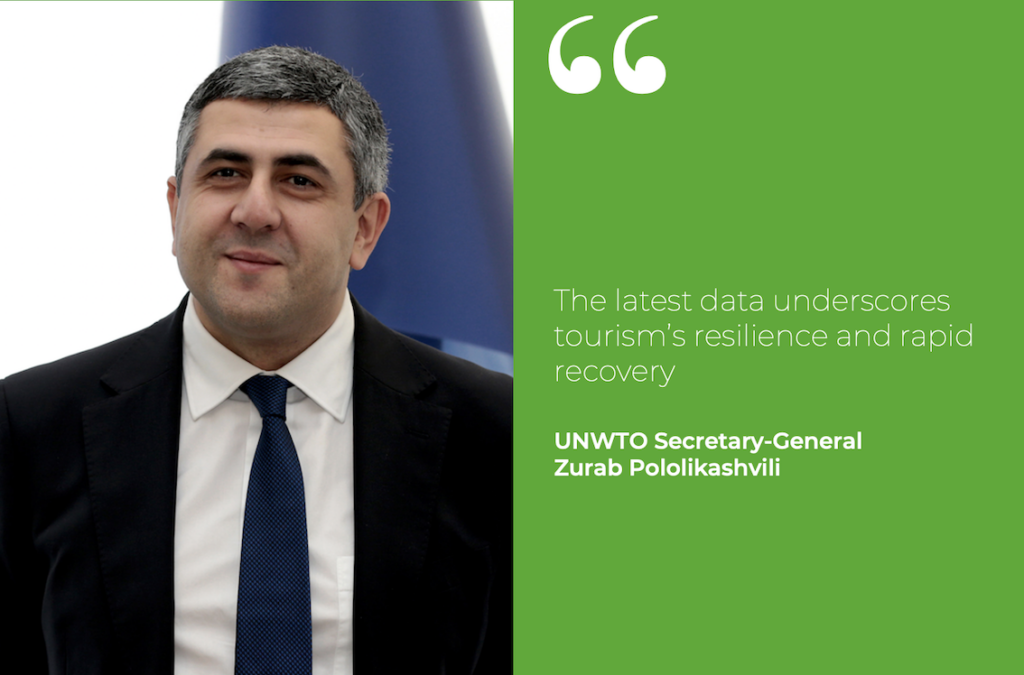INTERNATIONAL. The unleashing of pent-up demand, increased air connectivity and a stronger recovery of Asian markets are expected to underpin a full recovery in global tourism by the end of 2024.
That’s according to the UN World Tourism Organization, which today released its first World Tourism Barometer of the year. It noted that international tourism ended 2023 at 88% of pre-pandemic levels, with an estimated 1.3 billion international arrivals.

The Middle East led recovery in relative terms as the only region to overcome pre-pandemic levels with arrivals +22% above 2019.
Europe, the world’s most visited region, reached 94% of 2019 levels, supported by intra-regional demand and travel from the US.
Africa recovered 96% of pre-pandemic visitors and Americas reached 90%.
Asia and the Pacific reached 65% of pre-pandemic levels following the reopening of several markets and destinations. However, performance is mixed, with South Asia already recovering 87% of 2019 levels and North-East Asia around 55%.
Four sub-regions exceeded their 2019 arrival levels: Southern Mediterranean Europe, Caribbean, Central America and North Africa.
UNWTO Secretary-General Zurab Pololikashvili said: “The latest UNWTO data underscores tourism’s resilience and rapid recovery, with pre-pandemic numbers expected by the end of 2024. The rebound is already having a significant impact on economies, jobs, growth and opportunities for communities everywhere. These numbers also recall the critical task of progressing sustainability and inclusion in tourism development.”

The latest UNWTO data also highlights the economic impact of recovery. International tourism receipts reached US$1.4 trillion in 2023 according to preliminary estimates, about 93% of the US$1.5 trillion earned by destinations in 2019.
Several destinations reported strong growth in international tourism receipts during the first 10 to 12 months of 2023, exceeding in some cases growth in arrivals. Strong demand for outbound travel was also reported by several large source markets this period, with many exceeding 2019 levels, said UNWTO.
The sustained recovery is also reflected in the performance of industry indicators. According to the UNWTO Tourism Recovery Tracker, both international air capacity and passenger demand recovered about 90% of pre-pandemic levels through October 2023 (IATA). Global occupancy rates in accommodation establishments reached 64% in November, slightly above 62% in September 2022.
International tourism is expected to fully recover pre-pandemic levels in 2024, as noted above, with initial estimates pointing to +2% growth above 2019 levels.
The positive outlook is reflected in the latest UNWTO Tourism Confidence Index survey, with 67% of tourism professionals indicating better or much better prospects for 2024 compared to 2023. Some 28% expect similar performance, while only 6% expect tourism performance in 2024 to be worse than last year.
Key considerations include:
- There is still significant room for recovery across Asia. The reopening of several source markets and destinations will boost recovery in the region and globally.
- Chinese outbound and inbound tourism is expected to accelerate in 2024, due to visa facilitation and improved air capacity. China is applying visa-free travel for citizens of France, Germany, Italy, the Netherlands, Spain and Malaysia for a year to 30 November 2024.
- Visa and travel facilitation measures will promote travel to and around the Middle East and Africa with the Gulf Cooperation Council (GCC) countries to implement a unified tourist visa, similar to the Schengen visa, and measures to facilitate intra-African travel in Kenya and Rwanda.
- Europe is expected to drive results again in 2024. In March, Romania and Bulgaria will join the Schengen area of free movement, and Paris will host the Summer Olympics in July and August.
- Strong travel from the US, backed by a strong US Dollar, will continue to benefit destinations in the Americas and beyond. As in 2023, robust source markets in Europe, the Americas and the Middle East, will continue to fuel tourism flows and spending around the world.
- Economic and geopolitical headwinds continue to pose significant challenges to the sustained recovery of international tourism and confidence levels. Persisting inflation, high interest rates, volatile oil prices and disruptions to trade can continue to impact transport and accommodations costs in 2024.
- Against this backdrop, tourists are expected to increasingly seek value for money and travel closer to home. Sustainable practices and adaptability will also play an increasing role in consumer choice.
- Staff shortages remain a critical issue, as tourism businesses face a shortfall in labour to cope with high demand.
- The evolution of the Hamas-Israel conflict may disrupt travel in the Middle East impact traveller confidence. Uncertainty derived from the Russian aggression against Ukraine as well as other mounting geopolitical tensions, continue to weigh on confidence. ✈












